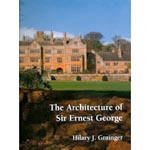Book Review: The Architecture of Sir Ernest George
Ernest George was a star in his own right, discovers Clive Aslet


To order any of the books reviewed or any other book in print, at
discount prices* and with free p&p to UK addresses, telephone the Country Life Bookshop on Bookshop 0843 060 0023. Or send a cheque/postal order to the Country Life Bookshop, PO Box 60, Helston TR13 0TP * See individual reviews for CL Bookshop price
Architecture
The Architecture of Sir Ernest George Hilary J. Grainger (Spire Books, £65, *£60)
Some of us owe Sir Ernest George an apology. We have seen him through the eyes of Sir Edwin Lutyens, who, on his way to greatness, briefly passed through George's office, and went on to despise an architect who gathered his ideas on the sketching tours that he made of the Continent every summer. It has taken Hilary J. Grainger to point out that George's watercolours and etchings were so accomplished as to win praise from as severe a critic as Ruskin.
As for the buildings, they could be far more sensitive to their surroundings than Lutyens implies. The village hall and market cross at Buscot, in the Cotswolds, are practically Arts-and-Crafts. George emerges from this masterly account as a kindly, self-effacing man, who was, nevertheless, the one star of the office.
A Londoner, he was brought up in Southwark. His father, a wholesale ironmonger, smiled on his son's artistic nature: if, on visits to France and Germany, he came back to find George still working on an unfinished sketch, he would, George remembered as an old man, quietly ‘light another cigar' and wait. Despite having begun his career in the office of Samuel Hewitt, a local but supposedly rising man, George got off to a flying start.
Exquisite houses, the beauty of Nature, and how to get the most from your life, straight to your inbox.
An early commission (1866) came from Peter Cow, of the eponymous gum, who was a resident of Streatham where George was then living. The same year, almost incredibly, the Duke of Wellington commissioned George and his partner Thomas Vaughan to build a house and wine stores on his Spanish estates. Before long, the firm was building Rousdon for the biscuit manufacturer Sir Henry Peek.
After Vaughan's early death-said to have been brought on by ‘brain fever' as a result of overwork-George designed every last baluster and corbel built by the firm himself. Full-sized drawings flowed fluently from his pencil. Harold Peto, who replaced Vaughan, has become known as a poet among garden designers, evoking dreamy Italian moods. It is clear, however, that he was a rather less comfortable person to be around than George, who left him, as the son of a successful railway contractor, to work up new clients.
Peto, who hated London, left the partnership in 1892. His place was taken by Alfred Yeates, an affable, bustling man, who, according to the former pupil Darcy Braddell, ‘did not mean much to the drawing office', being ‘hopelessly overshadowed by the dazzling personality and performance of his senior partner'.
Dazzling isn't always the word one would apply to George's many country houses. Taste was moving away from the bombast and theatricality of some mid-Victorian compositions, and George, perhaps temperamentally, preferred the pipe and slippers of an undemonstrative Elizabethan style, varied with bursts of Classicism in the Oxford wing at Welbeck Abbey and Crathorne Hall in Yorkshire. But the houses were admirably planned and could contain unexpected effects, such as a dramatically huge chimneyhood in a great hall. Estate buildings could be delightful; there are some indubitable masterpieces, such as the Ossington Coffee Palace and Hostelry at Newark-on-Trent.
It was George and Peto who invented the house style of the Cadogan Estate, which Osbert Lancaster would call Pont Street Dutch, and flâneurs around Harrington Gardens have much to thank them for. Lutyens may have pooh-poohed the months he spent in what was called the ‘Eton of architects' offices', but to others it was ‘that cradle of the English Domestic Revival'.
Country Life is unlike any other magazine: the only glossy weekly on the newsstand and the only magazine that has been guest-edited by His Majesty The King not once, but twice. It is a celebration of modern rural life and all its diverse joys and pleasures — that was first published in Queen Victoria's Diamond Jubilee year. Our eclectic mixture of witty and informative content — from the most up-to-date property news and commentary and a coveted glimpse inside some of the UK's best houses and gardens, to gardening, the arts and interior design, written by experts in their field — still cannot be found in print or online, anywhere else.
